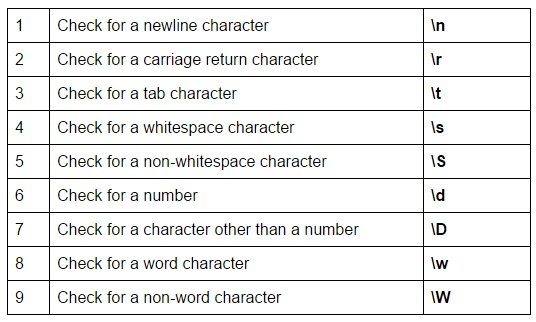
- #Regular expression not include character code#
- #Regular expression not include character plus#
#Regular expression not include character code#
For speed, Thompson implemented regular expression matching by just-in-time compilation (JIT) to IBM 7094 code on the Compatible Time-Sharing System, an important early example of JIT compilation. Among the first appearances of regular expressions in program form was when Ken Thompson built Kleene's notation into the editor QED as a means to match patterns in text files.

Regular expressions entered popular use from 1968 in two uses: pattern matching in a text editor and lexical analysis in a compiler. Other early implementations of pattern matching include the SNOBOL language, which did not use regular expressions, but instead its own pattern matching constructs. These arose in theoretical computer science, in the subfields of automata theory (models of computation) and the description and classification of formal languages. Regular expressions originated in 1951, when mathematician Stephen Cole Kleene described regular languages using his mathematical notation called regular events.
4.3 Deciding equivalence of regular expressions. Many programming languages provide regex capabilities either built-in or via libraries, as it has uses in many situations. Regular expressions are used in search engines, search and replace dialogs of word processors and text editors, in text processing utilities such as sed and AWK and in lexical analysis. Different syntaxes for writing regular expressions have existed since the 1980s, one being the POSIX standard and another, widely used, being the Perl syntax. They came into common use with Unix text-processing utilities. The concept of regular expressions began in the 1950s, when the American mathematician Stephen Cole Kleene formalized the description of a regular language. It is a technique developed in theoretical computer science and formal language theory. Usually such patterns are used by string-searching algorithms for "find" or "find and replace" operations on strings, or for input validation. Can be used in queries and saved for creating dashboard items.A blacklist on Wikipedia which uses regular expressions to identify bad titlesĪ regular expression (shortened as regex or regexp also referred to as rational expression ) is a sequence of characters that specifies a search pattern in text. Removes requirement for data to be in KVP formats. Is not dependant on any log type or structure. Uses standard RE2 regex syntax for named capture groups. This means you can create a type of Key Value Pairing out of non-Key Value Pair log formats. They can also be used for comparisons when creating alerts. By assigning a name to the identified value(s), these values can be used with our advanced search functions such as GroupBy() or for calculating values such as counts, sums, averages or unique instance counts. This gives you the ability to identify key pieces of information in your logs which are not in a Key Value Format such that search functions can be applied to the values in your logs. You can then use this named capture group to perform more complex search functions. Regex grouping and naming allows you to identify values in your log events and give these values a name, similar to having a Key value pair in your log events. Matches strings completed as well as Completed, compLeted, and ComplEįield’s value matches the regular expressionįield’s value does not match the regular expressionīasic Regular Expression Field Extraction Matches strings abc, acc, adc, but not ac. 
A RegEx search is placed within two slashes (“/”) and can include optional flags such as “i”.Įvents that contains Null, such as NullPointerExceptionĮvents that contains error, case insensitive, such as Error, ERRORĮvents that contains exception trace with a name InsightOps RegEx can be used independently or with any of the search functionality in the basic search documentation to provide advanced capability.

Matches any character except for those specified Matches any character except for whitespace Matches any character that is not a digit Matches at least the limit of the previous character Matches up to the limit of the previous character Matches the number of the previous character within the range. Matches the exact number of the previous character
#Regular expression not include character plus#
Plus matches at least one repetition of the previous character Star will match zero or more of the previous character , \,, (, ),, ^, $ If you need to use special characters as ordinary characters, you have to escape them with a backward slash. Regular expressions use special characters to enable searching for more advanced patterns. 1 where(/error/i) Building With Regular Express Operations







 0 kommentar(er)
0 kommentar(er)
